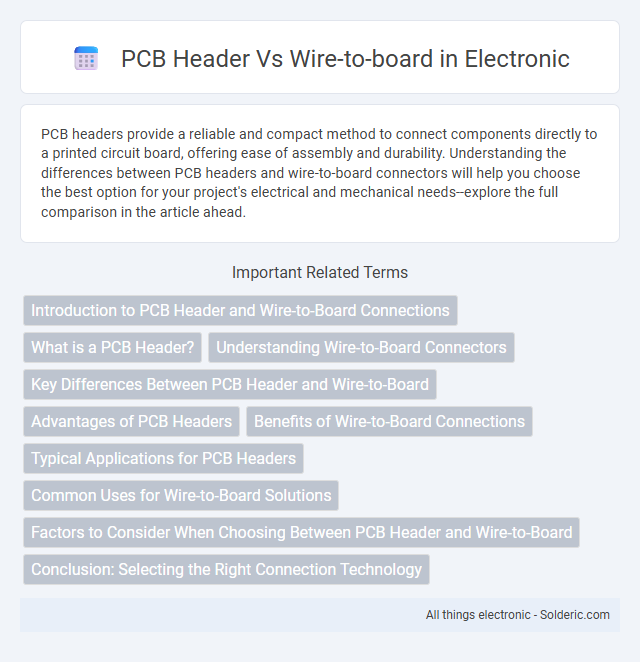PCB headers provide a reliable and compact method to connect components directly to a printed circuit board, offering ease of assembly and durability. Understanding the differences between PCB headers and wire-to-board connectors will help you choose the best option for your project's electrical and mechanical needs--explore the full comparison in the article ahead.
Comparison Table
| Feature | PCB Header | Wire-to-Board Connector |
|---|---|---|
| Function | Connects components directly on PCB | Connects external wires to PCB |
| Mounting Type | Through-hole or surface mount | Surface mount or through-hole terminals |
| Application | Internal board connections, daughterboards | External power, signal connections |
| Pin Count | Varies; single to multiple pins | Varies; typically fewer pins |
| Ease of Assembly | Simple PCB integration | Requires wire crimping or soldering |
| Durability | Moderate mechanical strength | High strain relief with proper design |
| Cost | Generally lower cost per unit | Higher due to cable and connector assembly |
Introduction to PCB Header and Wire-to-Board Connections
PCB headers are essential components that provide electrical connections between printed circuit boards (PCBs) and other electronic modules, enabling modular design and easy assembly. Wire-to-board connectors facilitate a secure interface where individual wires connect directly to a PCB, supporting reliable signal and power transmission in compact electronic assemblies. Both connection types optimize circuit integration but cater to different application requirements, such as modularity with PCB headers and direct wiring with wire-to-board connectors.
What is a PCB Header?
A PCB header is a type of connector that mounts directly onto a printed circuit board (PCB) to facilitate electrical connections between the board and external components or cables. It typically consists of a series of metal pins encased in a plastic housing, offering a reliable interface for wire-to-board or board-to-board connections. You can choose PCB headers for compact designs, secure connections, and ease of assembly in various electronic devices.
Understanding Wire-to-Board Connectors
Wire-to-board connectors enable secure and reliable electrical connections between a cable assembly and a printed circuit board (PCB), simplifying complex wiring setups. They are designed for easy mating and unmating, providing efficient signal and power transmission in compact electronic devices. Understanding your specific application requirements, such as current rating and environmental conditions, helps in selecting the appropriate wire-to-board connector for optimized circuit performance.
Key Differences Between PCB Header and Wire-to-Board
PCB headers are connector components soldered directly onto a printed circuit board, providing a fixed interface for modular connections, while wire-to-board connectors establish detachable connections between wires and PCB terminals. The key differences lie in their design purpose: PCB headers typically serve as male connectors with pin arrays, whereas wire-to-board systems include housings for wire insertion and locking mechanisms. Understanding these distinctions ensures your selection matches the required mechanical stability, electrical performance, and serviceability in electronic assemblies.
Advantages of PCB Headers
PCB headers offer reliable and compact connections that simplify circuit assembly and improve signal integrity in electronic devices. Their standardized pin configurations enable easy customization and compatibility with various wire-to-board connectors, enhancing design flexibility. High durability and low insertion force reduce wear and maintenance, making PCB headers ideal for repeated mating cycles in industrial applications.
Benefits of Wire-to-Board Connections
Wire-to-board connections offer enhanced flexibility and simplified assembly by allowing easy plug-and-play integration between wiring harnesses and printed circuit boards (PCBs). Their design reduces installation errors and maintenance time through reliable, solderless contacts, boosting overall system durability and electrical performance. This connection type supports compact device construction while facilitating rapid prototyping and streamlined manufacturing processes in electronics applications.
Typical Applications for PCB Headers
PCB headers are commonly used in computer motherboards, embedded systems, and industrial control equipment for establishing reliable electrical connections between PCBs. Typical applications include connecting peripheral devices, sensors, and modules where space-saving and ease of assembly are critical. Wire-to-board connectors are preferred in automotive, consumer electronics, and power supply units where secure, detachable wire harness connections are necessary.
Common Uses for Wire-to-Board Solutions
Wire-to-board connectors are commonly used in consumer electronics, automotive systems, and industrial equipment to securely connect wires directly to printed circuit boards without soldering. These connectors facilitate easy assembly and maintenance, supporting signals, power transmission, and high-speed data communication in compact spaces. Popular applications include LED lighting systems, appliance controls, and automotive sensors where reliable, quick-connect solutions enhance durability and reduce assembly time.
Factors to Consider When Choosing Between PCB Header and Wire-to-Board
When choosing between PCB headers and wire-to-board connectors, consider factors such as space constraints, connection reliability, and ease of assembly. PCB headers offer compact, low-profile mounting ideal for high-density applications, while wire-to-board connectors provide greater flexibility and durability in environments subject to vibration or frequent disconnection. Your decision should balance these factors alongside electrical requirements and mechanical stress to ensure optimal performance and longevity.
Conclusion: Selecting the Right Connection Technology
Selecting the right connection technology depends on your application's requirements for reliability, space constraints, and signal integrity. PCB headers offer secure, durable connections ideal for modular designs, while wire-to-board connectors provide flexibility for complex wiring configurations and easier assembly. Evaluating factors like current rating, mating cycles, and environmental conditions ensures you choose the optimal solution for your electronic project.
PCB header vs Wire-to-board Infographic

 solderic.com
solderic.com